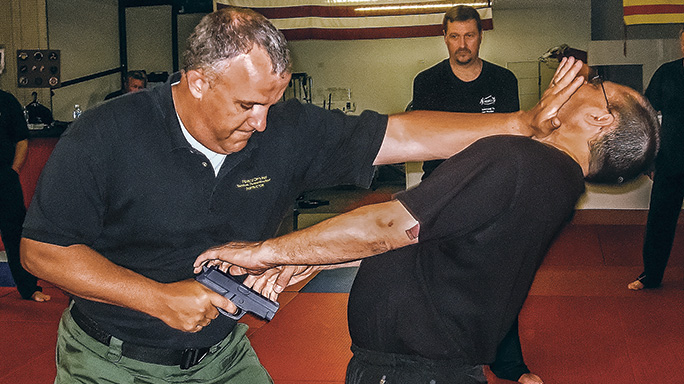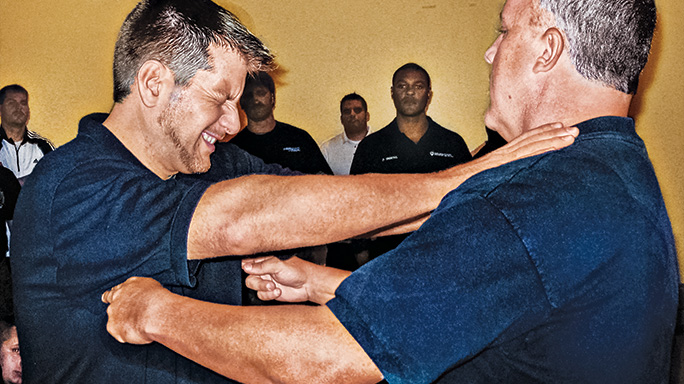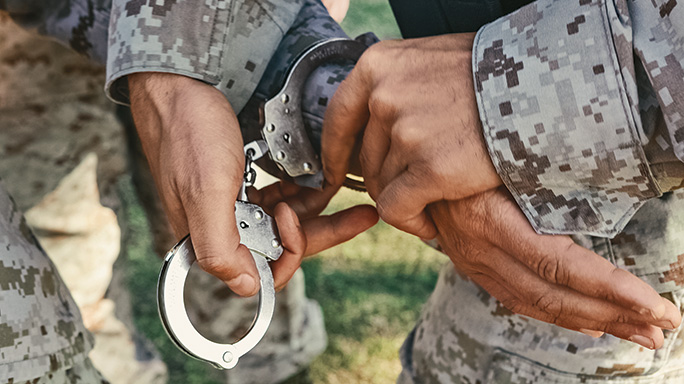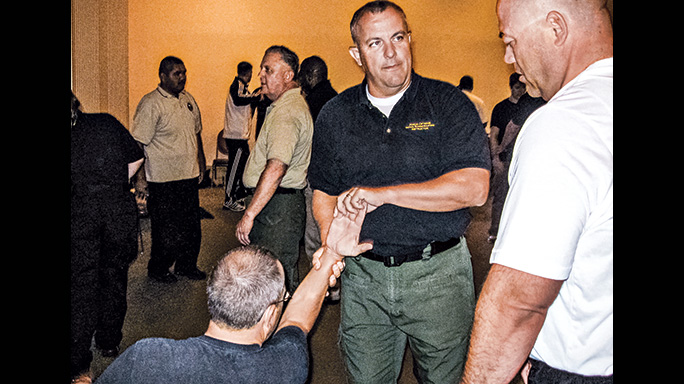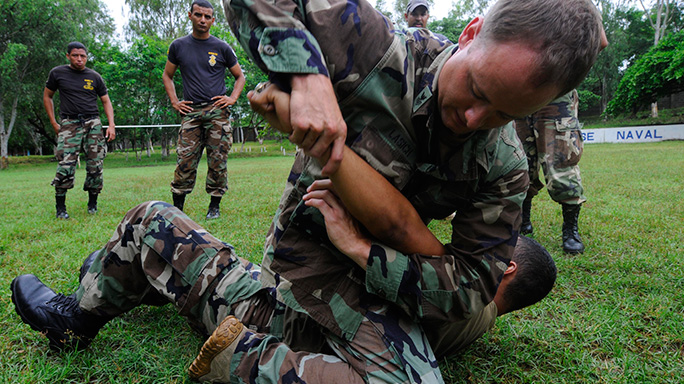A punch is thrown, and the officer moves to deflect and redirect it. In a flash the assailant is on the ground with little understanding of how they got there.
Just as quickly the officer is on top of them, applying handcuffs. While this has a modern-day feel to it, this episode could have taken place almost anywhere on earth for the last several thousand years. There is an undeniable link between modern defensive tactics taught in police academies, military bases and security institutes and the ancient dojo.
- RELATED STORY: Tactical Training: Chris Caracci’s Combat Mindset
While the modern police academy defensive tactics room looks little like a martial arts dojo, the lessons remain the same. Training gi’s are replaced with T-shirts and sweats. The sword is now an expandable baton, and the warrior wears a badge instead of a family crest. The techniques are taught in a slightly different manner, but the lessons remain the same. While possibly an oversimplification, these lessons can be broken down into five sections. First up is striking.
Advertisement — Continue Reading Below
Strike Through It
The idea of striking an adversary seems to be a simple matter. They attack you, and you throw a punch in reply. This is an oversimplification of effective technique, however. Senseis and drill instructors teach the same thing: If you are going to hit something, strike through it. To make contact with the surface and stop will result in a less-than-effective strike. By striking as if you are aiming at a point beyond your initial contact, you will get much deeper penetration into your target. Additionally, you are taught to strike with your entire body. A relaxed body concentrated behind a punch or kick allows the transfer of much more energy into the subject. This is essential for those who may not possess great strength or size.
Lock It Up
Advertisement — Continue Reading Below
Another essential skill in any combatives program is joint locking and manipulation. All officers must have the ability to manipulate a subject’s joints in order to not only control them but also to handcuff them as well. The world of joint manipulation is vast and complicated, yet pieces can be cut out for those wearing a badge. The primary principle behind joint control is moving a joint against its normal direction. This is accomplished by moving the joint away from the subject’s center to weaken it, then using your entire body to turn and control the joint.
The most common control points are the wrist and elbows. Used correctly, these controls can provide pain compliance and, more importantly, mechanical compliance. They can incapacitate an assailant and keep them from causing any further injury. A unique aspect of joint manipulations is their dual application nature. These controls allow an officer to control a subject, but if need be, they can break joints as well. If an assailant continues to be dangerous, an officer can damage a joint to a degree that the subject cannot utilize it in a continued assault. While not preferred, the option is available.
Combative Grappling
Advertisement — Continue Reading Below
In many cases, combative events end up on the ground. This, coupled with the huge popularity of MMA and the belief by many assailants that they are the next UFC champion, makes strong grappling skills a must. The difference, however, is that combative grappling is not a sport. There are no tap-outs or referees. The main goal in combative grappling is to either disable the assailant quickly or to get back onto your feet. The opportunity for the assailant’s friends to kick an officer in the head while they roll is very high. Even after an officer or soldier does disable an opponent, they need to get to their
feet as quickly as possible.
Using Weapons
The world of weapons in our context goes be-yond firearms. A student of combatives must have both offensive and defensive skills with a variety of weapons. The two most common are edged weapons and impact weapons. Edged weapons are extremely dangerous in that they are easily concealed, easy to use and silent. Traditional disarming techniques follow three components: Get off the line of attack, control the weapon and then control the assailant. The introduction of an edged weapon also elevates the event to a deadly-force incident. If the person is willing to take your life, then they should be considered a deadly, dedicated adversary. A kinetic response to the attack must be swift and overwhelming.
Advertisement — Continue Reading Below
Much of this applies to the introduction of an impact weapon as well. The flipside of this coin are skills that allow an officer or soldier offensive skills with these weapons. Training with impact weapons is common and for the most part is adequate. Offensive edged weapons training is almost non-existent, however. Without going into too much detail, the use of blades in traditional training is based on stopping the adversary. The most effective way to do this is to stab. Slashing does damage but is not nearly as effective as penetration into internal organs. This is a lethal-force option when a firearm is not available.
Survival Mindset
Of all the relevant training that has flowed from the dojo to the training room, focusing the mind is the most important. Samurai would dedicate years in training their mind to stay focused and calm during conflict. While the methods of mental training have changed, the lesson remains the same. A calm mind allows for more options to present themselves. Panic and overwhelming fear can cause irrational behavior and less-than-effective responses to threats. There is a Japanese phrase that sums up the most critical lesson in mental training: dochu-no-sei or “calmness in action.”
Advertisement — Continue Reading Below
In the end, there is little that differentiates modern students of combatives from ancient ones. Society has advanced to a great degree, yet there will always be those who wish to do harm to the innocent. Those who stand as guardians of the weak will always be the product of warrior training. They have been and will always be the product of sweat, pain and mental focus.
